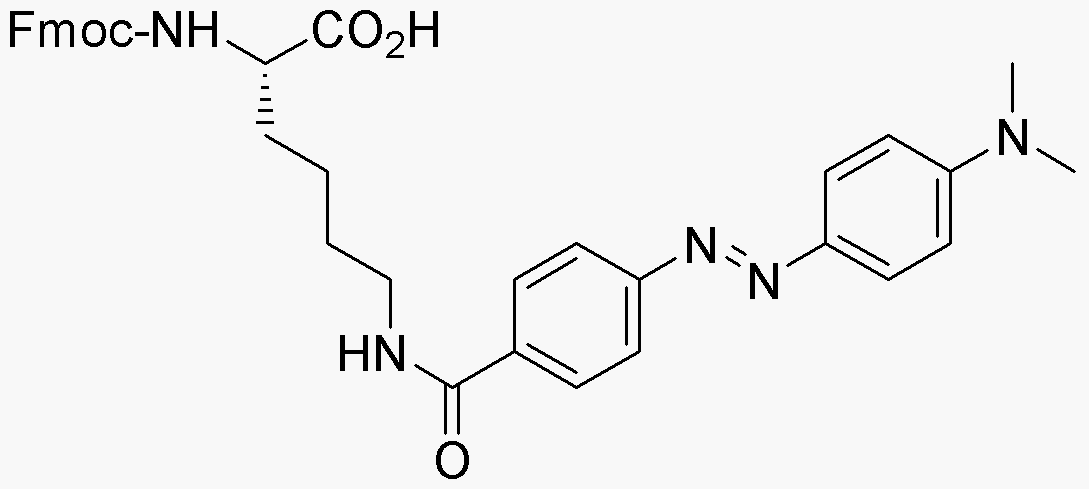Na-Fmoc-Ne-dimethylaminophenyldiazobenzoyl-L-lysine is widely utilized in research focused on:
- Peptide Synthesis: This compound serves as a protective group in peptide synthesis, allowing for the selective modification of amino acids. Its use helps streamline the process, making it easier to create complex peptides.
- Drug Development: In pharmaceutical research, it aids in the design of novel drug candidates by facilitating the incorporation of specific amino acid sequences, which can enhance the efficacy and specificity of therapeutic agents.
- Bioconjugation: The compound is valuable in bioconjugation techniques, linking biomolecules to create targeted drug delivery systems. This application is particularly relevant in cancer therapy, where precision is crucial.
- Fluorescent Labeling: It can be used for fluorescent labeling of peptides, enabling researchers to track and visualize biological processes in real-time, which is essential in cellular biology studies.
- Protein Engineering: This chemical plays a role in protein engineering, allowing scientists to modify protein structures for improved stability and functionality, which is vital in developing enzymes and therapeutic proteins.
General Information
Properties
Safety and Regulations
Applications
Na-Fmoc-Ne-dimethylaminophenyldiazobenzoyl-L-lysine is widely utilized in research focused on:
- Peptide Synthesis: This compound serves as a protective group in peptide synthesis, allowing for the selective modification of amino acids. Its use helps streamline the process, making it easier to create complex peptides.
- Drug Development: In pharmaceutical research, it aids in the design of novel drug candidates by facilitating the incorporation of specific amino acid sequences, which can enhance the efficacy and specificity of therapeutic agents.
- Bioconjugation: The compound is valuable in bioconjugation techniques, linking biomolecules to create targeted drug delivery systems. This application is particularly relevant in cancer therapy, where precision is crucial.
- Fluorescent Labeling: It can be used for fluorescent labeling of peptides, enabling researchers to track and visualize biological processes in real-time, which is essential in cellular biology studies.
- Protein Engineering: This chemical plays a role in protein engineering, allowing scientists to modify protein structures for improved stability and functionality, which is vital in developing enzymes and therapeutic proteins.
Documents
Safety Data Sheets (SDS)
The SDS provides comprehensive safety information on handling, storage, and disposal of the product.
Product Specification (PS)
The PS provides a comprehensive breakdown of the product’s properties, including chemical composition, physical state, purity, and storage requirements. It also details acceptable quality ranges and the product's intended applications.
Certificates of Analysis (COA)
Search for Certificates of Analysis (COA) by entering the products Lot Number. Lot and Batch Numbers can be found on a product’s label following the words ‘Lot’ or ‘Batch’.
Numéro de catalogue
Numéro de lot/série
Certificates Of Origin (COO)
This COO confirms the country where the product was manufactured, and also details the materials and components used in it and whether it is derived from natural, synthetic, or other specific sources. This certificate may be required for customs, trade, and regulatory compliance.
Numéro de catalogue
Numéro de lot/série
Safety Data Sheets (SDS)
The SDS provides comprehensive safety information on handling, storage, and disposal of the product.
DownloadProduct Specification (PS)
The PS provides a comprehensive breakdown of the product’s properties, including chemical composition, physical state, purity, and storage requirements. It also details acceptable quality ranges and the product's intended applications.
DownloadCertificates of Analysis (COA)
Search for Certificates of Analysis (COA) by entering the products Lot Number. Lot and Batch Numbers can be found on a product’s label following the words ‘Lot’ or ‘Batch’.
Numéro de catalogue
Numéro de lot/série
Certificates Of Origin (COO)
This COO confirms the country where the product was manufactured, and also details the materials and components used in it and whether it is derived from natural, synthetic, or other specific sources. This certificate may be required for customs, trade, and regulatory compliance.


